On Transform Domain Communication Systems under Spectrum Sensing Mismatch: A Deterministic Analysis
Abstract
:1. Introduction
2. System Models and Modulation Schemes
2.1. Transmitter Side of the TDCS
2.2. Two Waveform Modulation Schemes
2.3. Receiver Side of the TDCS
3. Spectrum Sensing Mismatch
3.1. Mathematical Model for Spectrum Sensing Mismatch
- for those bins available only at the transmitter side, with ;
- for those bins available only at the transmitter side, with ; and
- for those bins available at the same time both at the transmitter and the receiver, with .
- for receiver’s local reference signal, where ;
- for the received signal in the frequency domain (after equalization);
- for those after multiply with local reference signal ; and
- for the proposed mismatch factor, ().
3.2. Deterministic Analysis of Performance in AWGN Channels
3.3. Semi-Deterministic Analysis of Performance in Multipath Fading Channels
4. Simulation Results
4.1. AWGN Channels
4.2. Multipath Rayleigh Fading Channels
5. Conclusions
Acknowledgments
Author Contributions
Conflicts of Interest
References
- Mitola, J.; Maguire, G.Q. Cognitive radio: Making software radios more personal. IEEE Pers. Commun. 1999, 6, 13–18. [Google Scholar] [CrossRef]
- Mitola, J. Cognitive Radio: An Integrated Agent Architecture for Software Defined Radio. Ph.D. Thesis, Royal Institute Technol (KTH), Stockholm, Sweden, July 2000. [Google Scholar]
- He, S.; Huang, Y.; Jin, S.; Yang, L. Coordinated beamforming for energy efficient transmission in multicell multiuser systems. IEEE Trans. Commun. 2013, 61, 4961–4971. [Google Scholar] [CrossRef]
- Swackhammer, P.J.; Temple, M.A.; Raines, R.A. Performance simulation of a transform domain communication system for multiple access applications. In Proceedings of the IEEE Military Communications Conference Proceedings (MILCOM 1999), Atlantic City, NJ, USA, 31 October–3 November 1999; Volume 2, pp. 1055–1059. [Google Scholar]
- Nunez, A.S.; Temple, M.A.; Mills, R.F.; Raines, R.A. Interference Avoidance in Spectrally Encoded Multiple Access Communications Using MPSK Modulation. In Proceedings of the 2005 IEEE Wireless Communications and Networking Conference, New Orleans, LA, USA, 13–17 March 2005; pp. 730–734. [Google Scholar]
- Nunez, A.S. Interference Suppression in Multiple Access Communications Using M-Ary Phase Shift Keying Generated Via Spectral Encoding. Master’s Thesis, Air Force Institute of Technology, Wright-Patterson AFB, OH, USA, October 2012. [Google Scholar]
- Han, C.; Wang, J.; Yang, Y.; Li, S. Addressing the control channel design problem: OFDM-based transform domain communication system in cognitive radio. Comput. Netw. 2008, 52, 795–815. [Google Scholar] [CrossRef]
- Zhao, Y.; Anjum, M.N.; Song, M.; Xu, X.; Wang, G. Optimal Resource Allocation for Delay Constrained Users in Self-Coexistence WRAN. In Proceedings of the IEEE Global Communications Conference, San Diego, CA, USA, 6–10 December 2015; pp. 1–5. [Google Scholar]
- Jiao, Y.; Yin, P.; Joe, I. Clustering scheme for cooperative spectrum sensing in cognitive radio networks. IET Commun. 2016, 10, 1590–1596. [Google Scholar] [CrossRef]
- Jiao, Y.; Joe, I. Markov model-based energy efficiency spectrum sensing in Cognitive Radio Sensor Networks. J. Comput. Netw. Commun. 2016, 2016, 1–8. [Google Scholar] [CrossRef]
- Zhao, Y.; Hong, Z.; Wang, G.; Huang, J. High-Order Hidden Bivariate Markov Model: A Novel Approach on Spectrum Prediction. In Proceedings of the 25th IEEE International Conference on Computer Communication and Networks (ICCCN), Waikoloa, HI, USA, 1–4 August 2016; pp. 1–7. [Google Scholar]
- Zhao, Y.; Pradhan, J.; Wang, G.; Huang, J. Experimental approach: Two-stage spectrum sensing using GNU radio and USRP to detect primary user’s signal. In Proceedings of the 31st Annual ACM Symposium on Applied Computing, Pisa, Italy, 4–8 April 2016; pp. 2165–2170. [Google Scholar]
- So, J.; Sung, W. Group-Based Multibit Cooperative Spectrum Sensing for Cognitive Radio Networks. IEEE Trans. Veh. Technol. 2016, 65, 10193–10198. [Google Scholar] [CrossRef]
- Cacciapuoti, A.S.; Caleffi, M.; Izzo, D.; Paura, L. Cooperative Spectrum Sensing Techniques with Temporal Dispersive Reporting Channels. IEEE Trans. Wirel. Commun. 2011, 10, 3392–3402. [Google Scholar] [CrossRef]
- Cacciapuoti, A.S.; Caleffi, M. Interference Analysis for Secondary Coexistence in TV White Space. IEEE Commun. Lett. 2015, 19, 383–386. [Google Scholar] [CrossRef]
- Ding, G.; Wang, J.; Wu, Q.; Yao, Y.D.; Song, F.; Tsiftsis, T.A. Cellular-Base-Station-Assisted Device-to-Device Communications in TV White Space. IEEE J. Sel. Areas Commun. 2016, 34, 107–121. [Google Scholar] [CrossRef]
- Caleffi, M.; Cacciapuoti, A.S. Optimal Database Access for TV White Space. IEEE Trans. Commun. 2016, 64, 83–93. [Google Scholar] [CrossRef]
- Caleffi, M.; Cacciapuoti, A.S. On the achievable throughput over TVWS sensor networks. Sensors 2016, 16, 457. [Google Scholar] [CrossRef] [PubMed]
- Cacciapuoti, A.S.; Caleffi, M.; Paura, L. On the probabilistic deployment of smart grid networks in TV white space. Sensors 2016, 16, 671. [Google Scholar] [CrossRef] [PubMed]
- Lu, Q.; Yang, S.; Liu, F. Wideband Spectrum Sensing Based on Riemannian Distance for Cognitive Radio Networks. Sensors 2017, 17, 661. [Google Scholar] [CrossRef] [PubMed]
- Han, C.; Wang, J.; Gong, S.; Li, S. Detection and Performance of the OFDM-based Transform Domain Communication System. In Proceedings of the 2006 IEEE International Conference on Communications, Circuits and Systems Proceedings, Guilin, China, 25–28 June 2006; Volume 2, pp. 1332–1336. [Google Scholar]
- Hu, S.; Guan, Y.L.; Bi, G.; Li, S. Spectrally efficient transform domain communication system with quadrature cyclic code shift keying. IET Commun. 2013, 7, 382–390. [Google Scholar] [CrossRef]
- Hu, S.; Wu, G.; Xiao, Y.; Lei, X.; Li, S. Design of Low PAPR Fundamental Modulation Waveform for Transform Domain Communication System. Wirel. Pers. Commun. 2013, 71, 2215–2229. [Google Scholar] [CrossRef]
- Hu, S.; Wu, G.; Xiong, W.H.; Xiao, Y.; Dan, L; Li, S. TDCS Waveform Design for MUI-Free Cognitive Radio Networks. In Proceedings of the IEEE 78th Vehicular Technology Conference (VTC Fall), Las Vegas, NV, USA, 2–5 September 2013; pp. 1–5. [Google Scholar]
- Hu, S.; Liu, Z.; Guan, Y.L.; Xiong, W.H.; Li, B. Sequence Design for Cognitive CDMA Communications under Arbitrary Spectrum Hole Constraint. IEEE J. Sel. Areas Commun. 2014, 32, 1974–1986. [Google Scholar] [CrossRef]
- Dillard, G.M.; Reuter, M.; Zeidler, J.; Zeidler, B. Cyclic code shift keying: A low probability of intercept communication technique. IEEE Trans. Aerosp. Electron. Syst. Soc. 2003, 39, 786–798. [Google Scholar] [CrossRef]
- Fumat, G.; Charge, P.; Zoubir, A.; Fournier-Prunaret, D. Transform domain communication systems from a multidimensional perspective impacts on bit error rate and spectrum efficiency. IET Commun. 2011, 5, 476–483. [Google Scholar] [CrossRef]
- Chakravarthy, V.D.; Nunez, A.S.; Stephens, J.P. TDCS, OFDM, and MC-CDMA: A Brief Tutorial. IEEE Radio Commun. 2005, 43, S11–S16. [Google Scholar] [CrossRef]
- Stevenson, C.R.; Chouinard, G.; Lei, Z.; Hu, W.; Shellhammer, S.J.; Caldwell, W. IEEE 802.22: The first cognitive radio wireless regional area network standard. IEEE Commun. Mag. 2009, 47, 130–138. [Google Scholar] [CrossRef]
- Papoulis, A.; Pillai, S.U. Probability, Random Variables, and Stochastic Processes; McGraw-Hill Higher Education: New York, NY, USA, 2002. [Google Scholar]

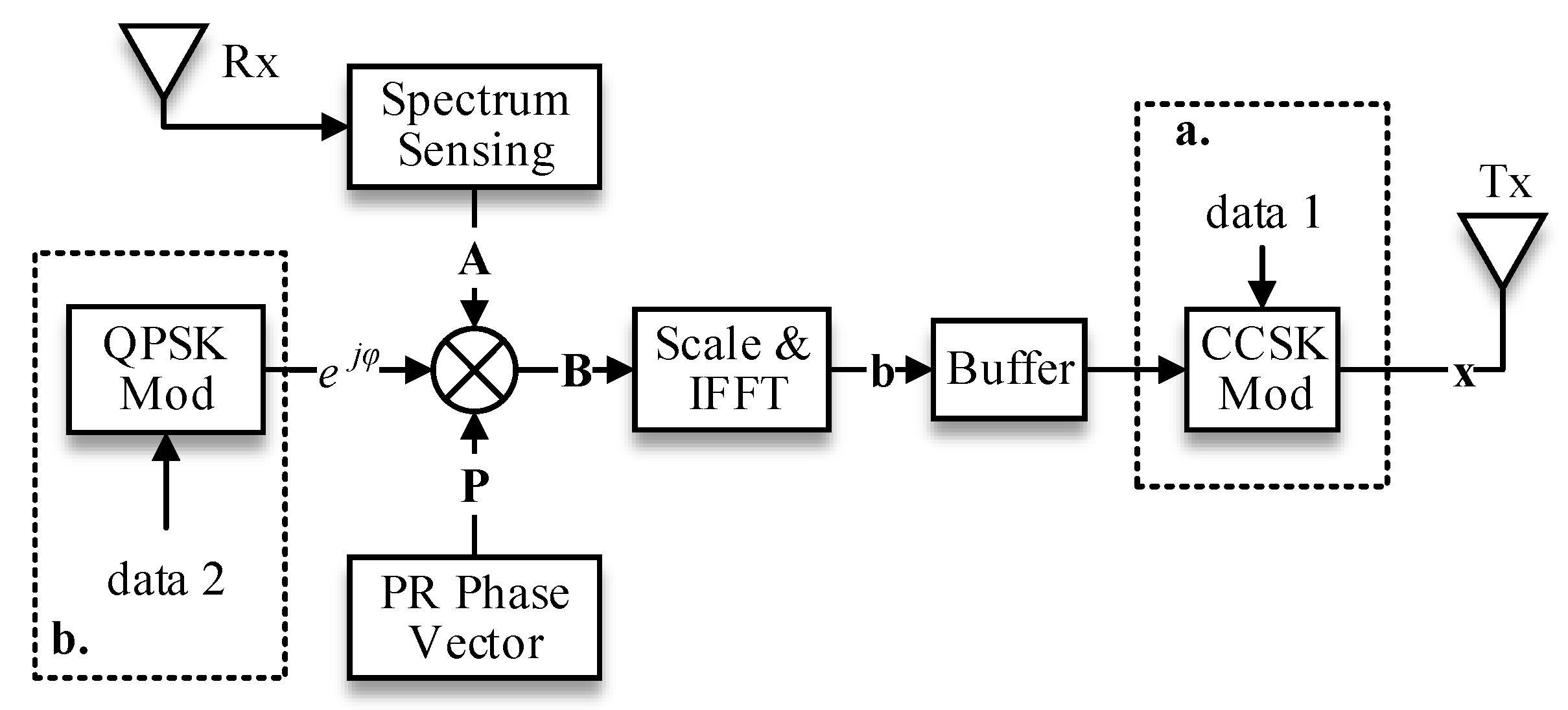

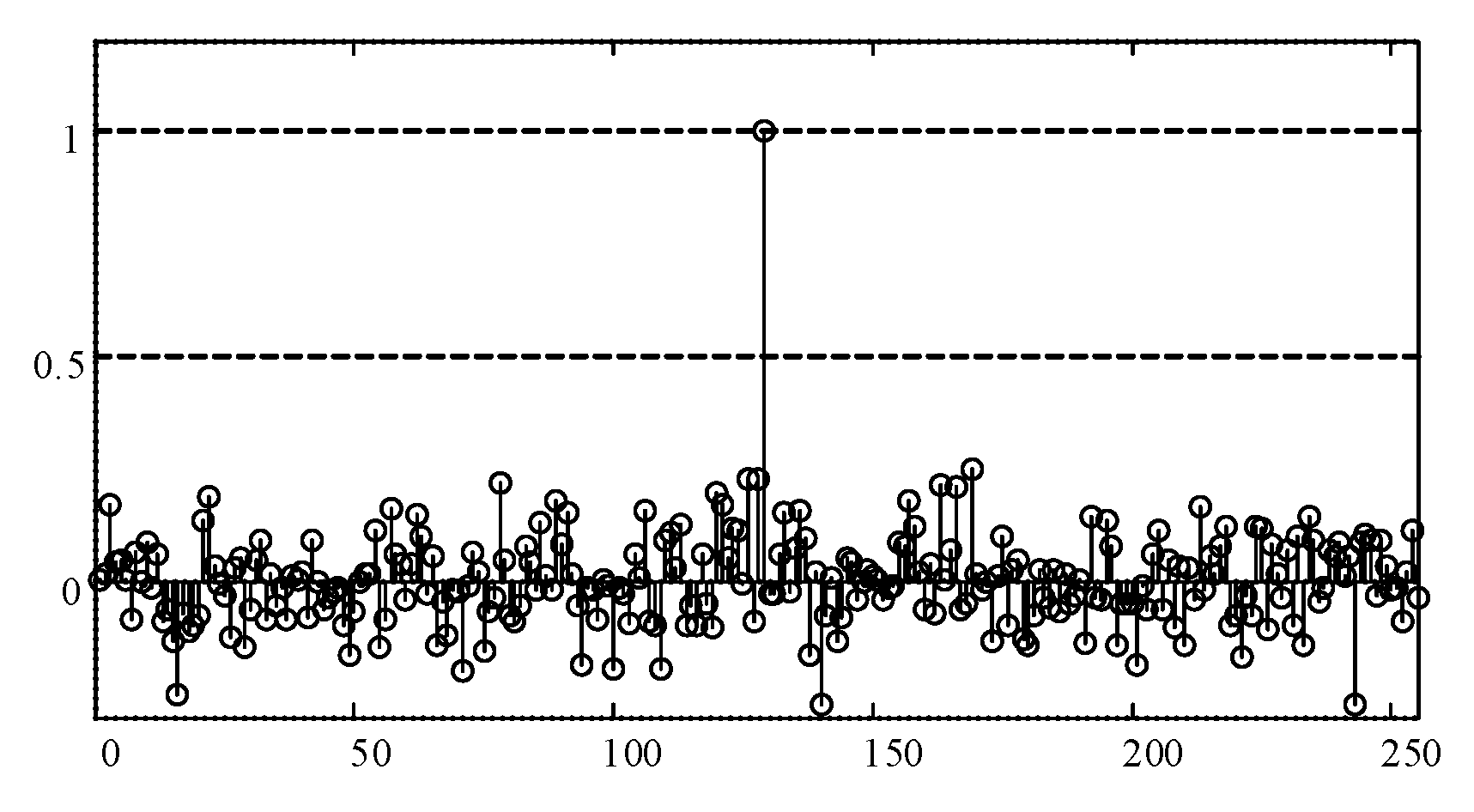
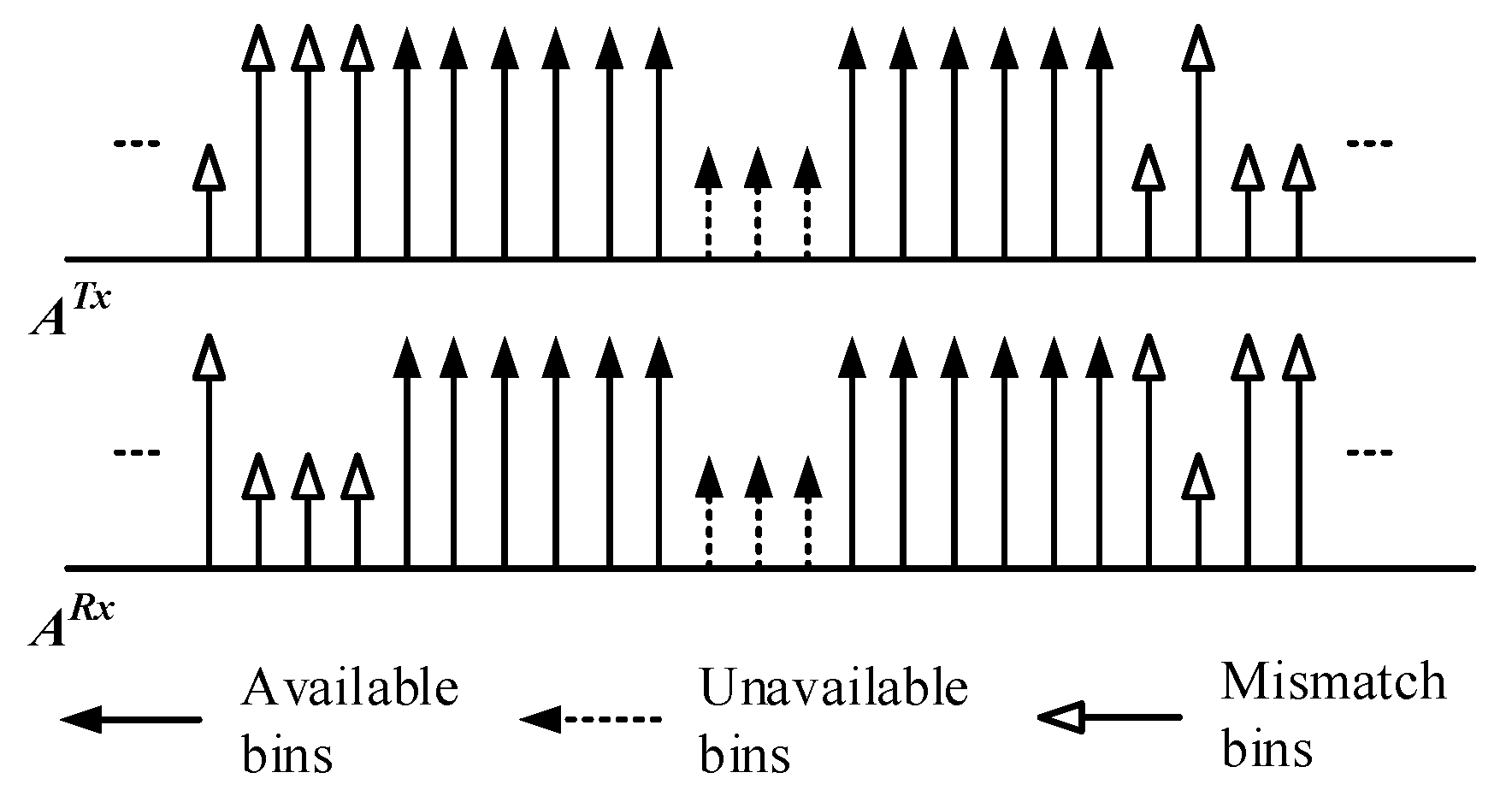
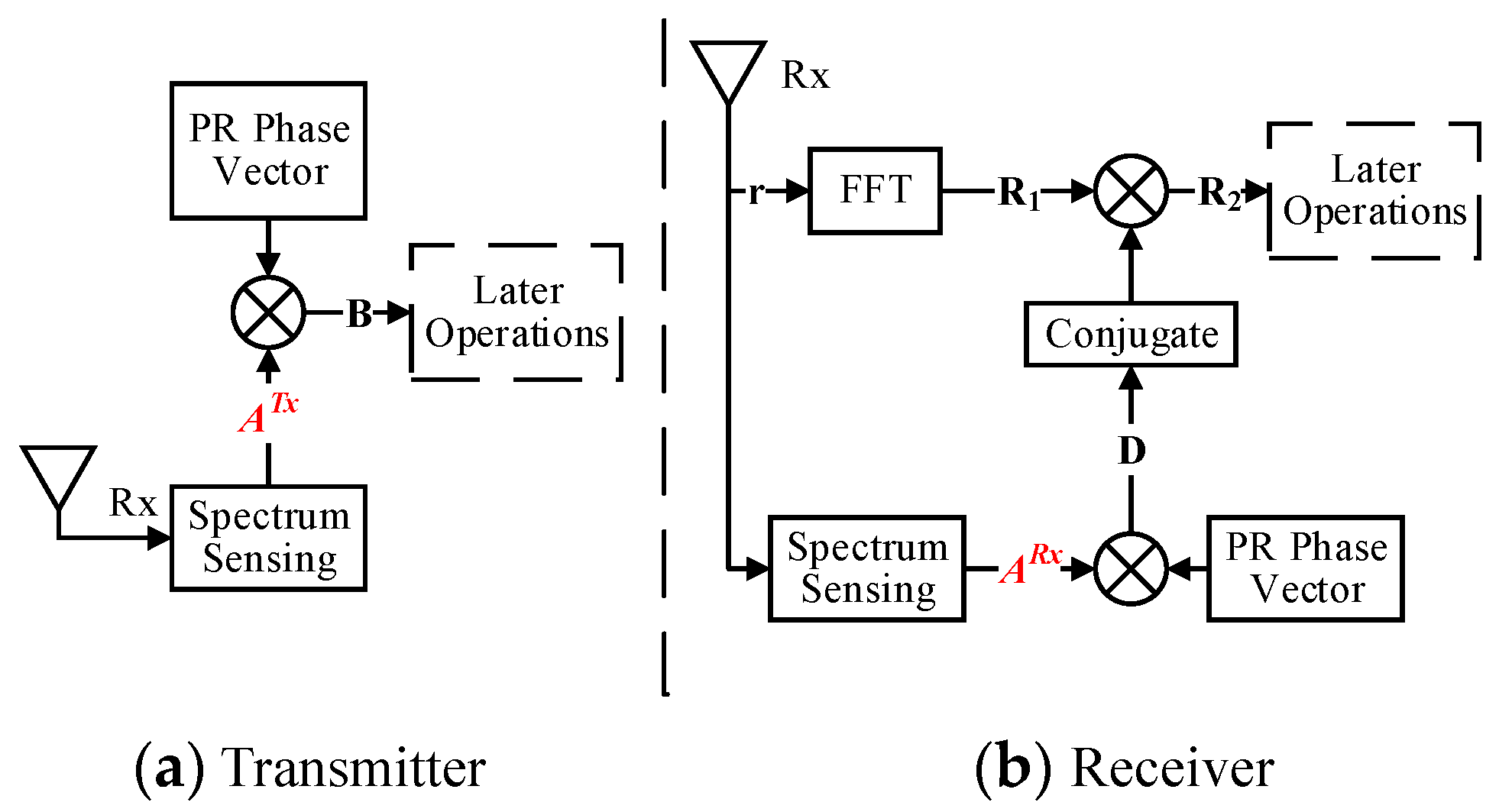
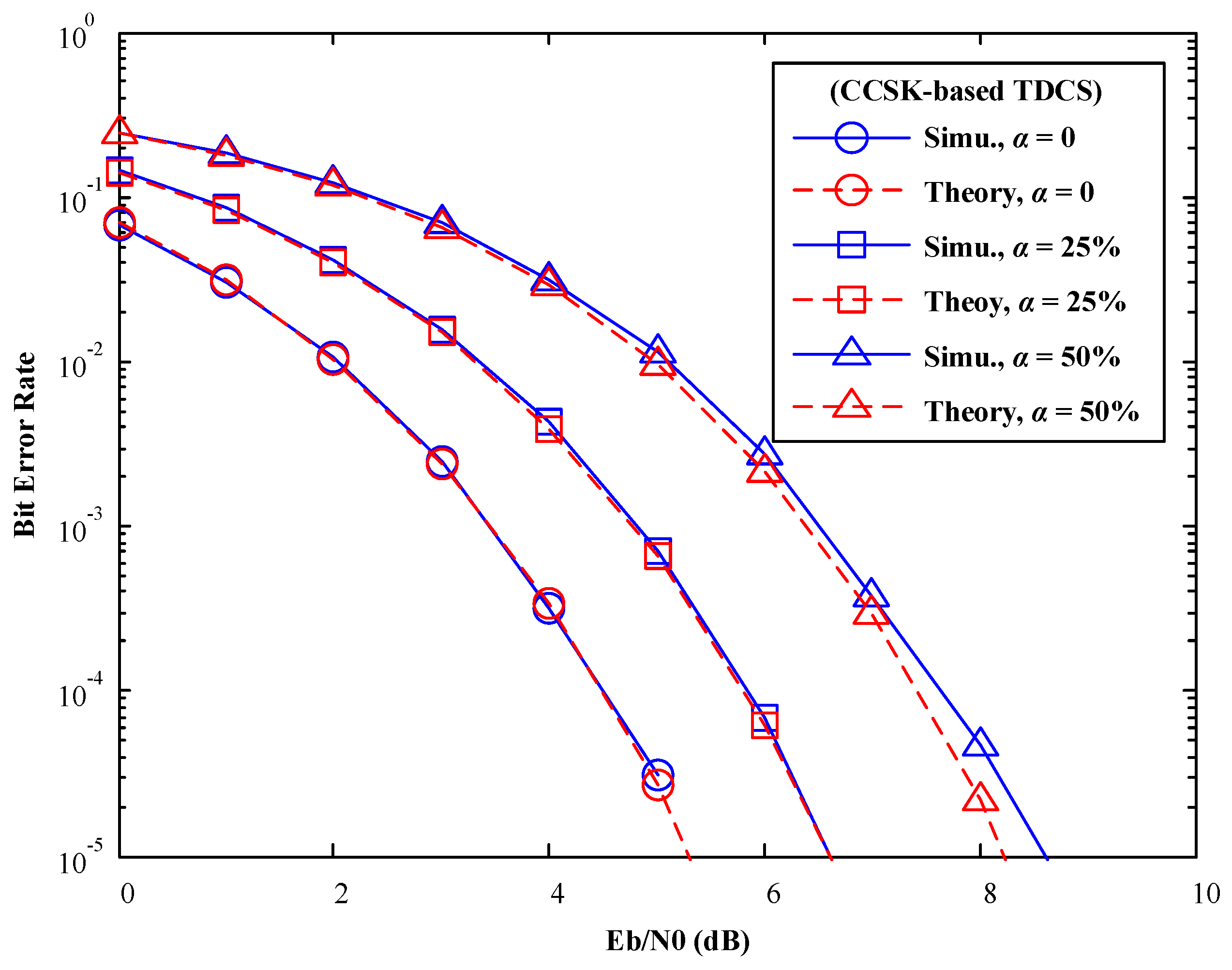
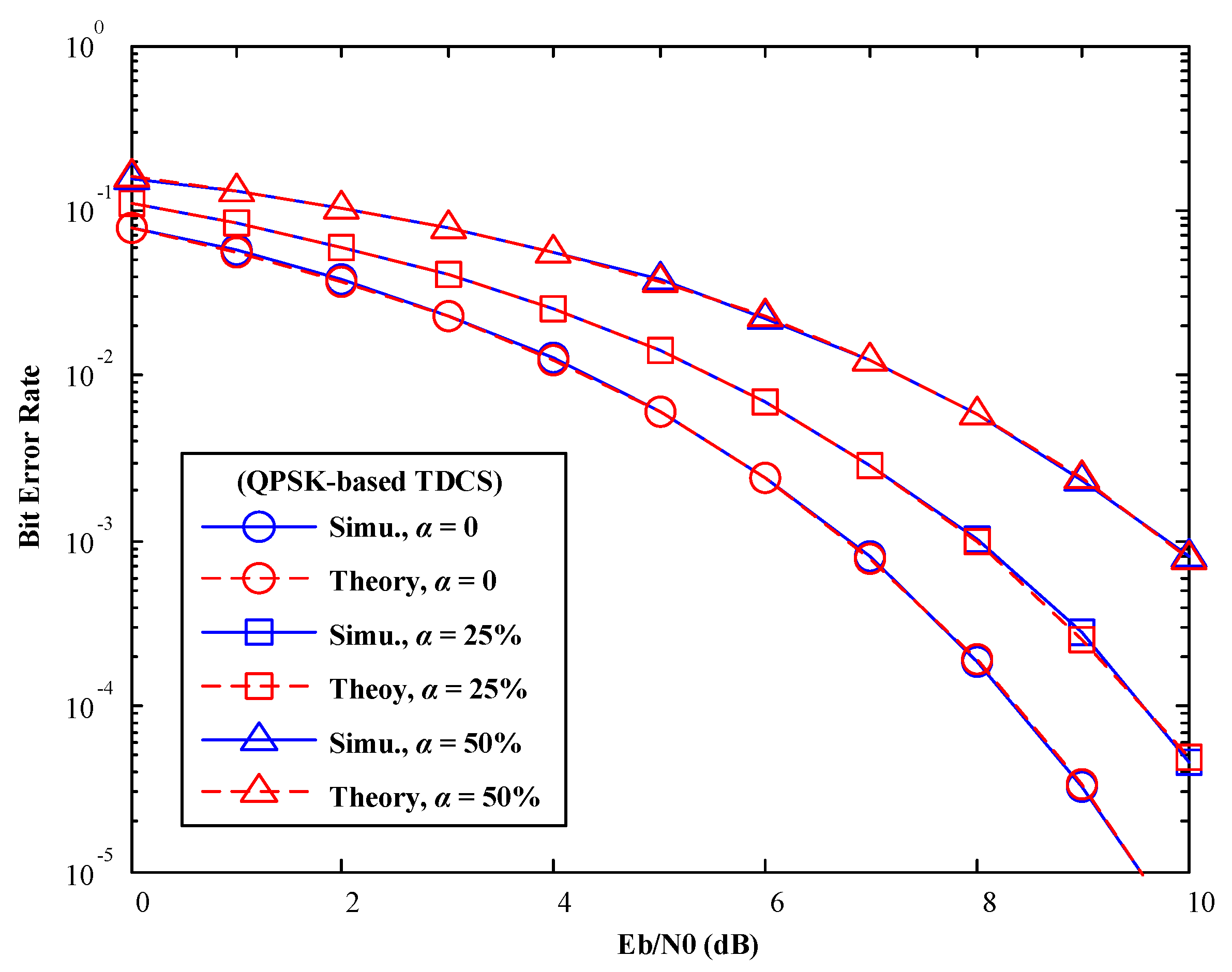
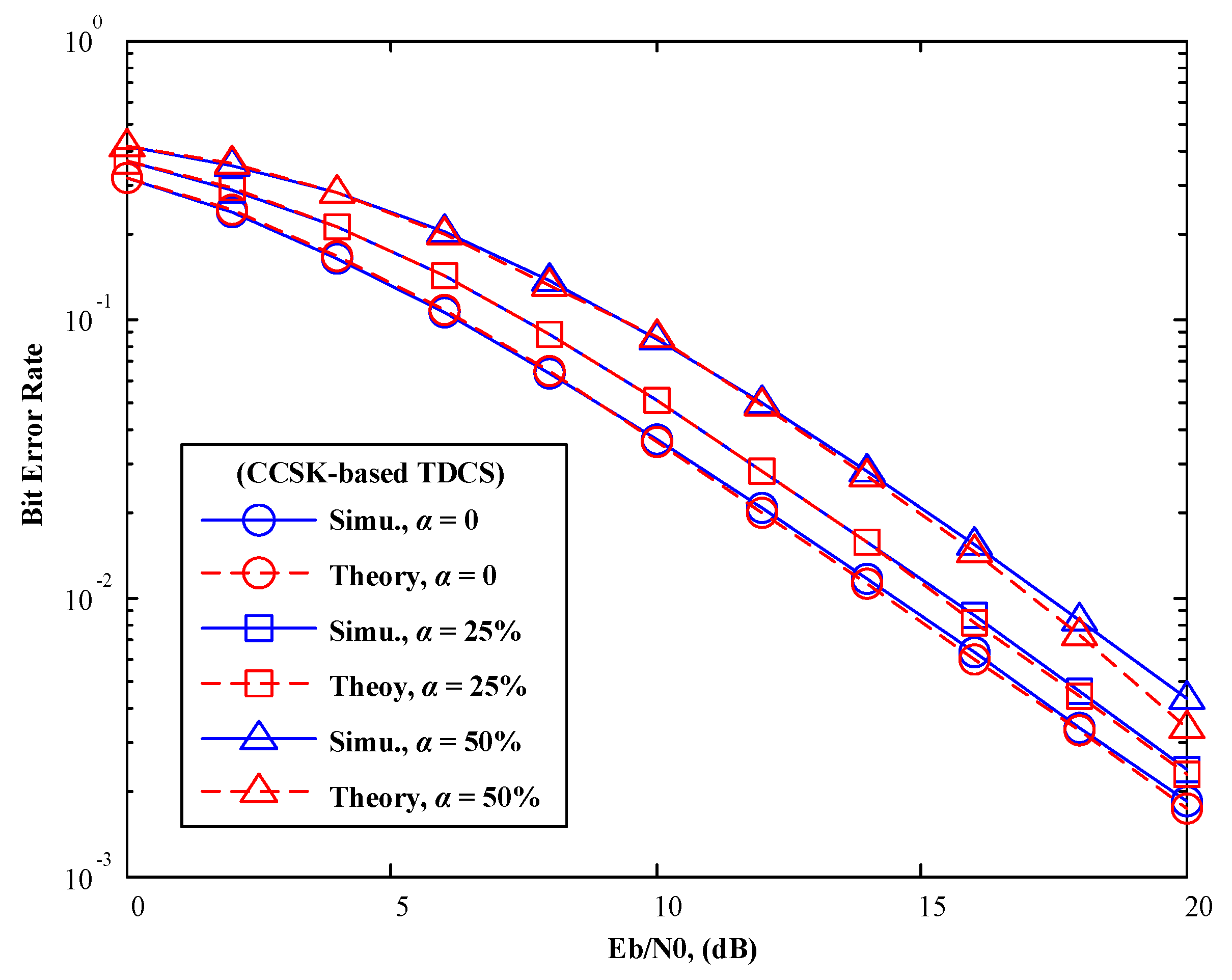
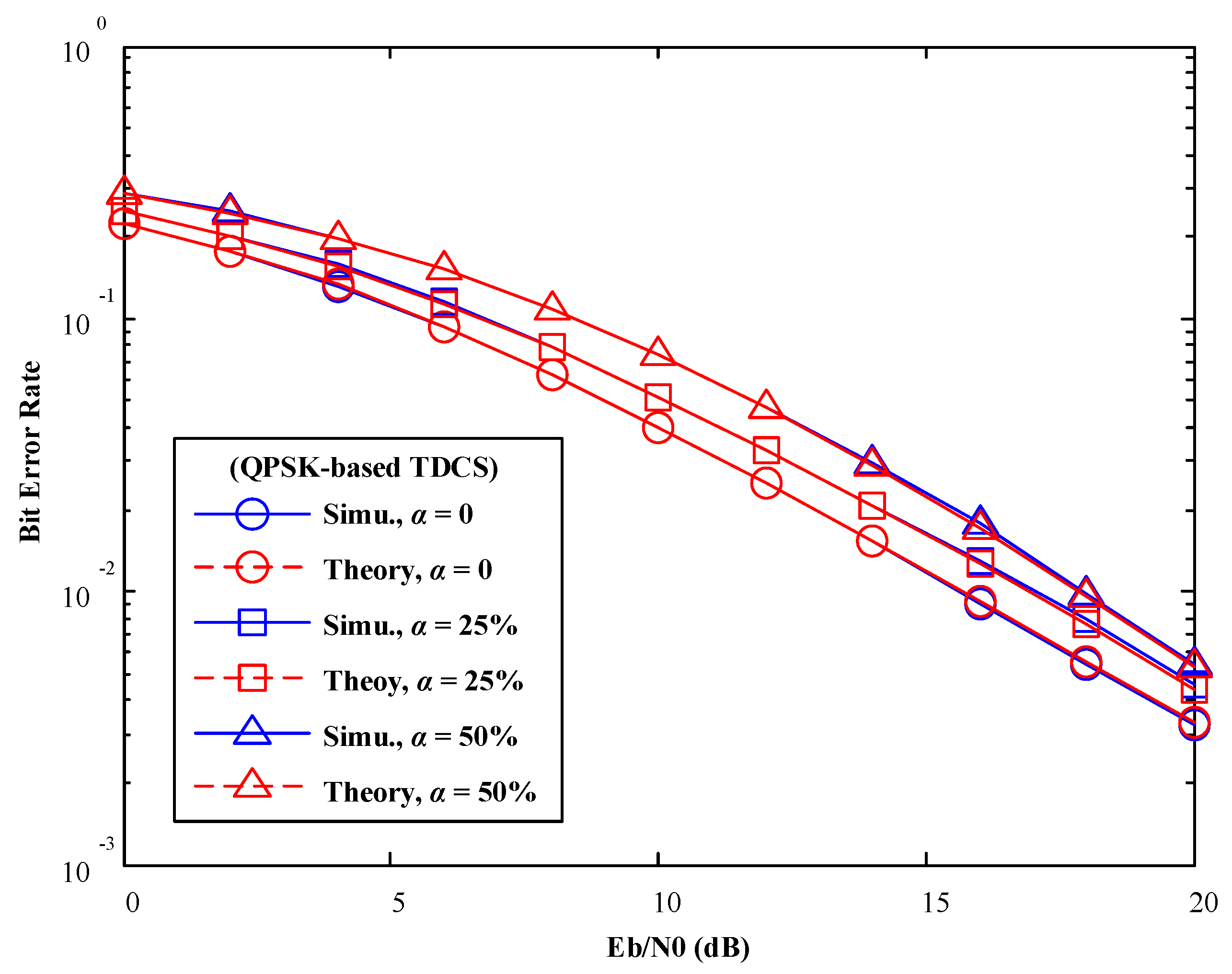
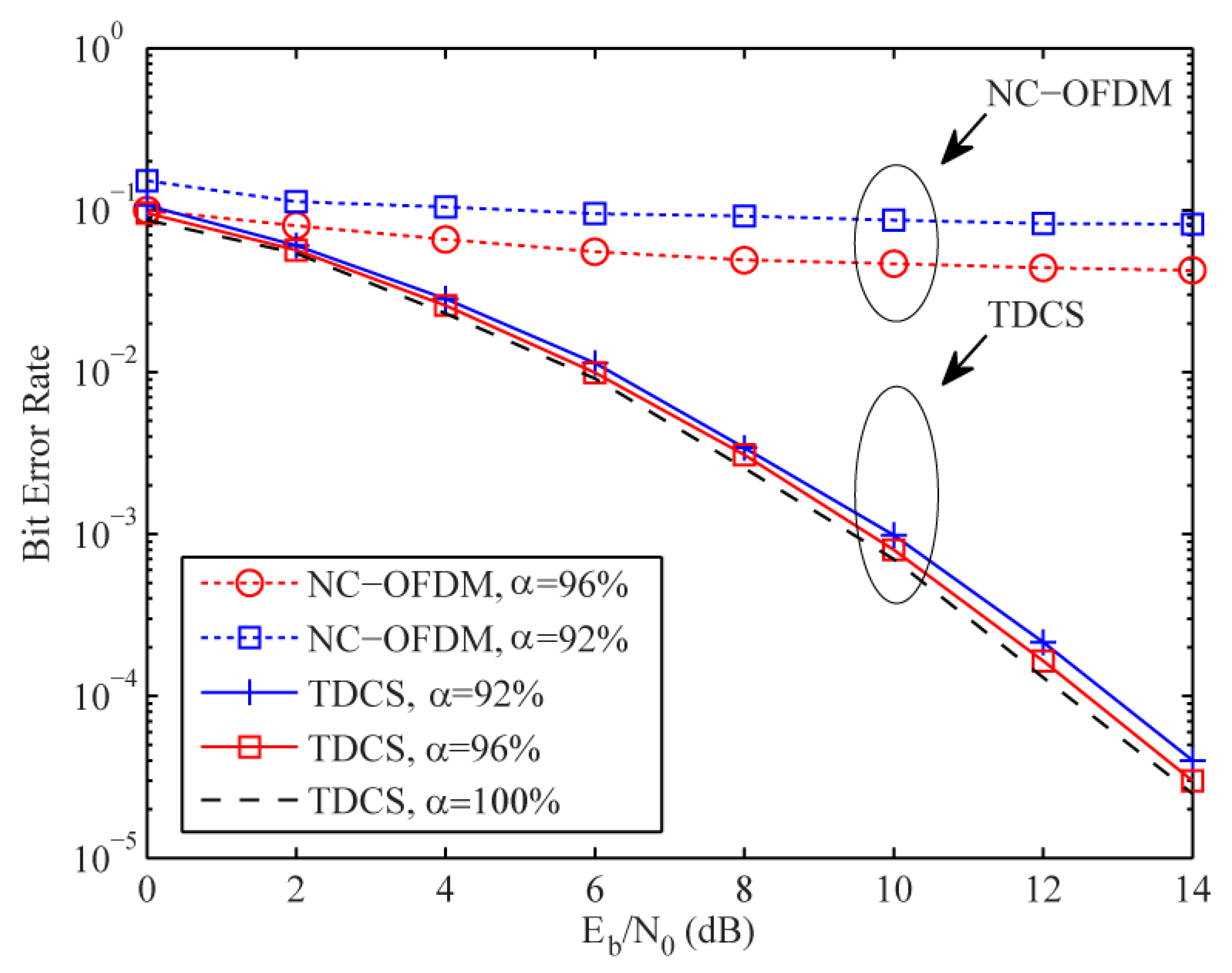
| Channels | AWGN Channel | COST207RAx6 Channel |
|---|---|---|
| Modulation model | CCSK/QPSK | CCSK/QPSK |
| Mismatch Factor (α) | 0 | 0 |
| 25% | 25% | |
| 50% | 50% |
© 2017 by the authors. Licensee MDPI, Basel, Switzerland. This article is an open access article distributed under the terms and conditions of the Creative Commons Attribution (CC BY) license (http://creativecommons.org/licenses/by/4.0/).
Share and Cite
Jin, C.; Hu, S.; Huang, Y.; Luo, Q.; Huang, D.; Li, Y.; Gao, Y.; Cheng, S. On Transform Domain Communication Systems under Spectrum Sensing Mismatch: A Deterministic Analysis. Sensors 2017, 17, 1594. https://doi.org/10.3390/s17071594
Jin C, Hu S, Huang Y, Luo Q, Huang D, Li Y, Gao Y, Cheng S. On Transform Domain Communication Systems under Spectrum Sensing Mismatch: A Deterministic Analysis. Sensors. 2017; 17(7):1594. https://doi.org/10.3390/s17071594
Chicago/Turabian StyleJin, Chuanxue, Su Hu, Yixuan Huang, Qu Luo, Dan Huang, Yi Li, Yuan Gao, and Shaochi Cheng. 2017. "On Transform Domain Communication Systems under Spectrum Sensing Mismatch: A Deterministic Analysis" Sensors 17, no. 7: 1594. https://doi.org/10.3390/s17071594
APA StyleJin, C., Hu, S., Huang, Y., Luo, Q., Huang, D., Li, Y., Gao, Y., & Cheng, S. (2017). On Transform Domain Communication Systems under Spectrum Sensing Mismatch: A Deterministic Analysis. Sensors, 17(7), 1594. https://doi.org/10.3390/s17071594







